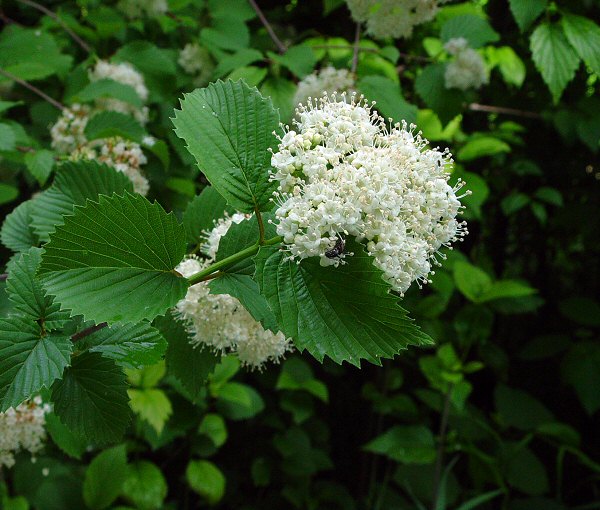Viburnum dentatum L.
Southern Arrowwood

Native
CC = 10
CW = 0
MOC = 7
SRank = S1
© DETenaglia
Viburnum dentatum L.Southern Arrowwood | |
 |
Native CC = 10 CW = 0 MOC = 7 SRank = S1 |
© DETenaglia |
|
Family - Caprifoliaceae Stems - Woody, multiple. A shrub to 5m tall. Twigs appearing somewhat glaucous but actually glabrous. New seasons growth glabrous, 5(6)-angled, with longitudinal grooves. Leaves - Opposite, petiolate, typically rounded but sometimes slightly cordate at base, toothed, orbicular to broadly-ovate, to 7.5cm long, lower surface dull green with tufts of hairs mostly in vein axils or on veins, upper surface shiny deeper green, glabrous. Inflorescence - Terminal, compound cymes (resembling compound umbels), to +13cm broad. Pedicles glabrous or with ferruginous stalked and sessile glands. Small scarious bracts present at base of each division of inflorescence.
Flowers - Corolla white, 4-5mm broad, 5-lobed, glabrous internally or with very few sparse hairs, glabrous externally, tube to 1.2mm long, 2-3mm broad, campanulate. Stamens 5, well exserted, alternating with corolla lobes. Filaments to 4mm long, white, glabrous, borne at base of corolla tube. Anthers yellow, .6mm long. Calyx tube to 2mm long, 1mm broad, cylindric, glabrous, 5-lobed. Lobes greenish-white, very small, tuberculate. Fruits - Globose, bluish-black, 5mm in diameter, single-seeded (drupes).
Flowering - May - June. Habitat - Low alluvial woods on terraces and wooded slopes. Widely cultivated. Origin - Native to U.S. Other info. - This plant is just one of the many species in this genus cultivated in Missouri. The plant can be identified by its suborbicular, dentate leaves (which have deeply impressed lateral veins). Photographs taken at the Kansas City Zoo, 5-8-00, at Powell Gardens, 8-17-99, and off the MKT Trail, Columbia, MO., 5-18-04. |